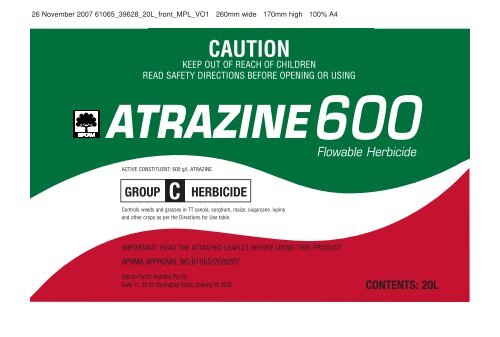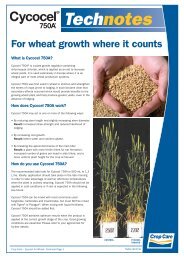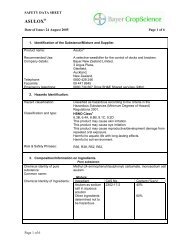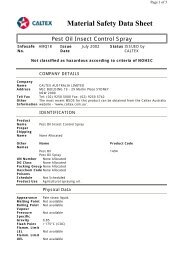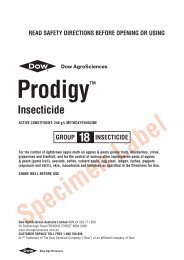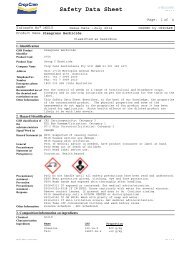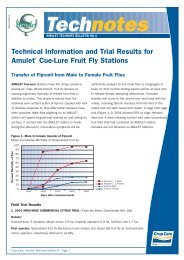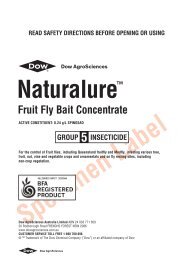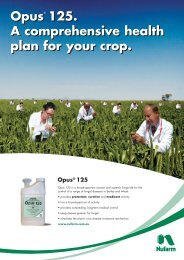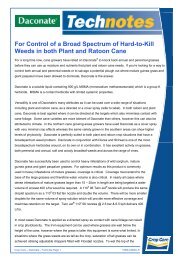Create successful ePaper yourself
Turn your PDF publications into a flip-book with our unique Google optimized e-Paper software.
26 November 2007 61065_39628_20L_front_MPL_VO1 260mm wide 170mm high 100% A4<br />
CAUTION<br />
KEEP OUT OF REACH OF CHILDREN<br />
READ SAFETY DIRECTIONS BEFORE OPENING OR USING<br />
ATRAZINE600<br />
Flowable Herbicide<br />
ACTIVE CONSTITUENT: 600 g/L ATRAZINE<br />
GROUP<br />
C<br />
HERBICIDE<br />
Controls weeds and grasses in TT canola, sorghum, maize, sugarcane, lupins<br />
and other crops as per the Directions for Use table.<br />
IMPORTANT: READ THE ATTACHED LEAFLET BEFORE USING THIS PRODUCT<br />
APVMA APPROVAL NO:61065/20/0207<br />
Sipcam Pacific Australia Pty Ltd<br />
Suite 11, 23-31 Gheringhap Street, Geelong Vic 3220<br />
CONTENTS: 20L
26 November 2007 61065_39628_leaflet_MPL_VO1 420mm wide 297mm high 100%<br />
CAUTION<br />
KEEP OUT OF REACH OF CHILDREN<br />
READ SAFETY DIRECTIONS BEFORE OPENING OR USING<br />
ATRAZINE600<br />
Flowable Herbicide<br />
WITHHOLDING PERIODS:<br />
HARVEST<br />
GRAZING<br />
ALL CROPS<br />
CANOLA<br />
SITUATION<br />
OTHER CROPS<br />
PRE-EMERGENCE<br />
APPLICATION<br />
POST-EMERGENCE<br />
APPLICATION<br />
WITH-HOLDING PERIOD<br />
NOT REQUIRED WHEN USED AS DIRECTED<br />
DO NOT GRAZE FOR STOCK FOOD FOR 15 WEEKS<br />
AFTER APPLICATION<br />
DO NOT GRAZE FOR STOCK FOOD UNTIL 6 WEEKS<br />
AFTER APPLICATION<br />
NOT REQUIRED WHEN USED AS DIRECTED<br />
ACTIVE CONSTITUENTS: 600 g/L ATRAZINE<br />
Controls weeds and grasses in TT canola, sorghum, maize, sugarcane, lupins<br />
and other crops as per the Directions for Use table.<br />
THIS LEAFLET IS PART OF THE LABEL<br />
APVMA APPROVAL NO 61065/1007<br />
DIRECTIONS FOR USE<br />
RESTRAINTS:<br />
DO NOT apply to waterlogged soil.<br />
DO NOT apply if heavy rains or storms that are likely to cause surface runoff are forecast within 2 days of application.<br />
DO NOT irrigate to the point of runoff for at least 2 days after application.<br />
DO NOT use as a pre-emergence application in sorghum, broom millet, or saccaline during the wet season in the<br />
Northern Irrigation areas of Western Australia.<br />
SOIL MOISTURE: This product requires rainfall or irrigation to move it down into the weed root zone to make it effective.<br />
Sufficient rain or irrigation to thoroughly wet the soil through the weed root zone should occur or be made within<br />
10 days after spraying.<br />
CROP AREAS<br />
SITUATION & CROP<br />
Canola – (Triazine<br />
Tolerant varieties<br />
only)<br />
Pre emergence<br />
or post sowing pre<br />
emergence only<br />
Canola – (Triazine<br />
Tolerant varieties<br />
only) post emergence<br />
GROUP<br />
WEEDS<br />
CONTROLLED<br />
Capeweed, Charlock,<br />
Clover, Corn<br />
Gromwell, Doublegee,<br />
Fumitories,<br />
Geraniums, Ivy-leaf<br />
Speedwell, London<br />
Rocket, Mustards,<br />
Turnips, Paterson’s<br />
Curse, Shepherd‘s<br />
Purse, Silver Grass<br />
(Vulpia)<br />
Suppression of Annual<br />
Ryegrass, Barley<br />
Grass, Brome<br />
Grass, Wild Oats and<br />
Wild Radish<br />
Annual ryegrass (1 to<br />
2 leaf stage only),<br />
Mustards, Wild<br />
Radish, Turnips<br />
C<br />
HERBICIDE<br />
STATE RATE/ha CRITICAL COMMENTS<br />
All<br />
States<br />
1.7 to<br />
3.3L<br />
830mL to<br />
1.7L<br />
Important: This use is subject to an Integrated<br />
Weed Management Strategy for<br />
the use of triazine herbicides in triazine<br />
tolerant canola.<br />
See General Instructions: Integrated<br />
Weed Management Strategy for TT-<br />
Canola.<br />
Can be applied up to a week before sowing<br />
or post-sowing pre-emergence (ideally Incorporated<br />
by harrows). For best results<br />
apply to bare moist soil, either immediately<br />
before seeding or as a pre-emergence<br />
treatment at or within 7 days of planting.<br />
Sufficient rainfall (20-30 mm) to wet the soil<br />
through the weed root zone is necessary<br />
within 2-3 weeks of application. Application<br />
should not be made to ridged or excessively<br />
cloddy soil. When applied before<br />
seeding, incorporate to a depth of 5cm.<br />
Important: This use is subject to an Integrated<br />
Weed Management Strategy for<br />
the use of triazine herbicides in triazine<br />
tolerant canola.<br />
See General Instructions: Integrated<br />
Weed Management Strategy for TT-<br />
Canola.<br />
Apply to moist soil when weeds are actively<br />
growing. The addition of 0.5 to 1% v/v of<br />
crop oil will enhance post-emergence activity.<br />
Cold water: Under cold water conditions<br />
(10°C or less), use Hasten crop oil. DO<br />
NOT apply more than one post-emergence<br />
application.<br />
DO NOT APPLY MORE THAN 5 LITRES PRODUCT/HA/YEAR EXCEPT IN FORESTRY SITUATIONS<br />
GENERAL INSTRUCTIONS<br />
Sipcam Atrazine 600 Flowable Herbicide is a pre and post emergent herbicide which will selectively control:<br />
Weeds and grasses in canola (triazine tolerant varieties only), sorghum, maize, sweet corn, sugar cane, lupins, broom<br />
millet, saccaline and forage sorghum.<br />
Mintweed in established lucerne.<br />
Brome grass in sirocco phalaris, demeter fescue and currie cocksfoot grass seed crops.<br />
Provide control of weeds and grasses growing on a fallow in a conversation tillage system.<br />
Duration and effectiveness of control depends on the amount of chemical applied, soil type, rainfall and<br />
particular weed species.<br />
Established perennial species will not be satisfactorily controlled at the rates recommended.<br />
The maximum rate of atrazine application in all crops except plantation forestry is limited to an amount of<br />
product equivalent to 3 kg ai atrazine/ha per year. DO NOT exceed this limit, especially when applying an<br />
atrazine herbicide post-emergence, where an atrazine herbicide has been applied pre-emergence.<br />
The maximum rate of application in plantation forestry is an amount of product equivalent to 4.5kg ai<br />
atrazine/ha per year in sandy soils and those defined as highly erodible ,and product equivalent to 8 kg ai<br />
atrazine/ha per year in clay loam and heavier textured soils.<br />
Incorporation (Pre-plant and at sowing application)<br />
This product acts mainly by root absorption. Its effectiveness depends on the occurrence of rainfall or irrigation to<br />
move it down into the weed root zone. Sufficient rain or irrigation to thoroughly wet the soil through the weed root<br />
zone should occur or be made immediately after application to provide appropriate weed control. Delay in activation<br />
of this product may result in some weed growth. In flood or furrow irrigation situations complete and continued<br />
activation of the product due to a thin hard band of dry soil on the surface during or after irrigation. Mechanical<br />
incorporation after application, using light harrows to incorporate the product into the soil not more than 4 cm deep is<br />
required to ensure the irrigation water activates the product.<br />
INTEGRATED WEED MANAGEMENT STRATEGY FOR TT CANOLA<br />
An Integrated Weed Management Strategy for TT Canola (the Strategy) has been developed with the assistance of the<br />
Canola Association of Australia. The Strategy outlines recommendations, measures and options for weed management<br />
including management of herbicide resistance in weed populations.<br />
The strategy is available from the Canola Association of Australia . A program has been developed that outlines sound<br />
agronomic practices and integrated weed management practices designed to optimise the performance of TT canola.<br />
It is advised that consultation of IWM be undertaken with an accredited agronomist prior to the use of this product on<br />
TT canola.<br />
Resistant Weeds Reporting<br />
Growers should collect plant or seed samples where weeds that are normally susceptible to atrazine and simazine<br />
may be resistant, get them tested and seek professional advice.<br />
Important: Use may not control canola escapes or weedy canola relatives if triazine tolerant. Sipcam, the<br />
Canola Association of Australia, neighbouring land managers and growers should be notified of suspected<br />
incidents of resistance.<br />
To minimise herbicide resistance:<br />
Avoid dry sowing in heavily weed infested paddocks. Wait for a weed germination after the opening rains in weedy<br />
paddocks. Use a pre-plant knockdown or cultivation. No weeds should be allowed to survive at this stage.<br />
Adapt the weed control program to the anticipated weed spectrum and pressure:<br />
Broadleaf Weeds and Ryegrass: Use Sipcam Simazine 600 Flowable Herbicide or Sipcam Atrazine 600 Flowable<br />
Herbicide plus trifluralin pre-emergence. A follow-up with a Group A herbicide (if ryegrass is susceptible) or Sipcam<br />
Atrazine 600 Flowable Herbicide may be necessary.<br />
Broadleaf Weeds only: Use Sipcam Atrazine 600 Flowable Herbicide post-emergence.<br />
DO NOT use Sipcam Simazine 600 Flowable Herbicide or Sipcam Atrazine 600 Flowable Herbicide if the area to be<br />
treated had a triazine herbicide applied to it last season.<br />
Watch for escapes, especially in paddocks with a long history of Group C herbicide use.<br />
DO NOT use Group C herbicides in consecutive years.<br />
To avoid Triazine carry-over:<br />
On acid soils (pH less than 6.5) - The maximum rate of use of Sipcam Simazine 600 Flowable Herbicide or<br />
Sipcam Atrazine 600 Flowable Herbicide or a combination of the two products to be applied to the crop during the<br />
growing season is 3.3 L/ha.<br />
On alkaline soils (pH greater than 6.5) - The maximum rate of use of Sipcam Simazine 600 Flowable Herbicide or<br />
Sipcam Atrazine 600 Flowable Herbicide or a combination of the two products to be applied to the crop during the<br />
growing season is 1.7 L/ha.<br />
Post-emergence use - It is recommended that Sipcam Atrazine 600 Flowable Herbicide only be used, and at rates<br />
of 1.7 L/ha or less, on both acid or alkaline soils.<br />
Eucalyptus and Pinus<br />
radiata plantations<br />
Lucerne<br />
Grass seed crops,<br />
(Established stands of<br />
Sirocco Phalaris,<br />
Demeter fescue,<br />
Currie Cocksfoot)<br />
Seedling Signal<br />
Grass, and Panicum<br />
maximum<br />
Capeweed, Clovers,<br />
Mouse eared Chickweed,<br />
Rye Grass,<br />
Sand Brome, Silver<br />
grass, Common Sow<br />
Thistle, Spear Thistle<br />
seedlings, Yorkshire<br />
Fog, Wild Oats<br />
Mintweed<br />
Brome grass<br />
Billygoat weed (Blue<br />
top), Crowsfoot<br />
grass, Cobblers<br />
Pegs, Fleabanes,<br />
Lovegrass, Mexican<br />
Poppy, Rhodes<br />
grass, Setaria sp,<br />
Sida sp., Stinking<br />
Roger, Thickhead,<br />
Wild Hops, Wild<br />
Radish, Woolly Top<br />
NSW,<br />
ACT,<br />
Vic, Tas,<br />
SA, WA<br />
only<br />
All<br />
States<br />
All<br />
States<br />
Qld only<br />
7.5 to<br />
13L<br />
920mL<br />
1.5 to<br />
1.8L<br />
3.7 to 5L<br />
Pre-planting: Graze the area heavily and<br />
apply the tank mixture by boom spray or<br />
aircraft no more than two weeks before<br />
planting.<br />
Post-Planting: Apply the mixture by boom<br />
spray either immediately after or within one<br />
month of planting. When applying by<br />
aircraft, the pines must be at least one<br />
month old. Application must me made<br />
before the spring flush commences. Use<br />
rate towards the lower end of the range<br />
where broadleaf weeds are the major<br />
problem and rates<br />
towards the higher end of the range where<br />
grasses are the major problem. Use up to<br />
13 litres per hectare on clay loams and<br />
heavier textured soils. For sandy soils and<br />
soils described as highly erodible, apply a<br />
maximum of 7.5 litres per hectare.<br />
DO NOT apply with a knapsack sprayer.<br />
Apply when the first germination of<br />
mintweed seedlings are 5-8cm high and<br />
actively growing. Using low volume boom<br />
spray apply 140 to 170 litres of spray<br />
mixture/ha.<br />
Apply by after the autumn break when<br />
Brome grass is just emerging. Apply by low<br />
volume boom spray.<br />
Pre-emergence: Apply at or immediately<br />
after planting, preferably to moist soil, and<br />
before weeds and crop germinate.<br />
Use the lowest rate on Panicum maximum<br />
seed crops and the highest rate on Signal<br />
Grass when grasses are likely to be a major<br />
problem.<br />
Guinea grass, panics and summer grasses<br />
are not controlled.<br />
Warning: Damage can occur to Panicum<br />
maximum where application is made under<br />
cool dry conditions.<br />
Note: When used in Signal Grass and Panicum<br />
maximum user accepts all responsibility<br />
should any damage occur. Refer to<br />
Incorporation in General Instructions.<br />
Summer crops<br />
Heavy rains immediately after application may result in excessive concentrations of herbicide in the seed furrow, thus<br />
encouraging crop injury. This is most likely to occur in pre-plant or pre-emergence applications using rates in excess<br />
of 3.6L/ha. To avoid the likelihood of herbicide injury use technique (a), (b) or (d) in the Time of Application table below.<br />
Time of Application - Sorghum, Broom millet, Saccaline, Maize and Sweet Corn<br />
Pre-plant or pre-emergence applications are preferred where grasses are the major problem.<br />
TYPE OF APPLICATION<br />
(a) Pre-plant application<br />
followed by Post-Emergence<br />
Application<br />
(b) At sowing application -<br />
followed by Post-Emergence<br />
Application<br />
(c) At sowing application<br />
(d) Post-Emergence Application<br />
CRITICAL COMMENTS<br />
Apply after establishment of the seed bed and up to two weeks prior to sowing.<br />
Application should be made preferably to moist soil and rain or irrigation should<br />
follow application immediately. Mechanical incorporation may also assist. If<br />
using this technique on irrigated crops then a Post-Emergence application must<br />
be made as soon as possible after crop emergence and development of 2-3<br />
leaves.<br />
Apply at or immediately after planting and before crop and weeds emerge.<br />
Application should be made preferably to moist soil and rain or irrigation should<br />
follow application immediately. Mechanical incorporation may also assist.<br />
If using this technique on irrigated crops then a Post-Emergence application<br />
must be made as soon as possible after crop emergence and development of<br />
2-3 leaves.<br />
Apply at or immediately after planting before crop and weeds emerge.<br />
Preferably apply to moist soil and rain or irrigation should follow application<br />
immediately. Mechanical incorporation may also assist.<br />
Application must be made to seedling broadleaf weeds and grasses when they<br />
are not more than 1cm high. Normally than the crop is at the 2-3 leaf stage.<br />
For best results the soil should be moist and rain or irrigation should follow<br />
application immediately. Add a non-ionic surfactant for all Post-Emergence<br />
applications sorghum , broom millet and saccaline and a crop oil at the<br />
recommended rate to the spray mixture for maize and sweet corn.<br />
Mixing<br />
DO NOT mix, load or apply this product within 20m of any well, sink hole, intermittent or perennial stream.<br />
Settling may occur after storage for some weeks. Stir the product or invert the container several times prior to use. Pour<br />
the product into the spray vat through a strainer to remove any dry particles or flakes, which can occasionally occur<br />
under hot storage conditions. Add the full quantity of Sipcam Atrazine 600 Flowable to the partially filled spray tank while<br />
agitating. Fill tank and agitate to ensure thorough mixing. Continue agitation while spraying. Agitate vigorously from the<br />
bottom if allowed to stand. Reseal partly used container immediately.<br />
Compatibility<br />
This product is compatible with Glyphosate formulations, paraquat, Paraquat / diquat mixtures, ametryn, ametryn /<br />
prometryn, dicamba, hexazinone and amitrole.
Grass Pastures<br />
Lupins - weed free<br />
seed bed<br />
Maintenance of fallow<br />
areas prior to planting<br />
a sorghum crop in a<br />
conservation tillage<br />
system.<br />
Maize, Sweet corn<br />
Irrigated and dryland<br />
Potatoes<br />
Giant Sensitive<br />
Plant<br />
Capeweed , Clovers<br />
and Medics, Doublegee,<br />
Mustard,<br />
Turnip, Wild Radish,<br />
Wireweed.<br />
Suppression of annual<br />
grass weeds.<br />
Amaranthus, Annual<br />
Ground Cherry,<br />
Barnyard Grass ,<br />
Blackberry<br />
Nightshade, Black<br />
bindweed, Bladder<br />
Ketmia, Burrs,<br />
Cobbler’s Pegs,<br />
Common thornapple,<br />
Crowsfoot Grass,<br />
Dwarf Marigold,<br />
Fathen, Lovegrass,<br />
Mintweed, Prickly<br />
Paddy melon,<br />
Parthenium weed,<br />
Pigeon grass,<br />
Pigweed, Plains<br />
grass, Potato weed ,<br />
Sesbania pea,<br />
Spring grass,<br />
Summer grass ,<br />
Sunflowers, Wild<br />
Oats, Wireweed,<br />
Yellow vine<br />
Amaranthus , Annual<br />
Ground Cherry,<br />
Barnyard Grass ,<br />
Blackberry Nightshade,<br />
Black<br />
bindweed (Climbing<br />
buckwheat), Black<br />
pigweed, Bladder<br />
Ketmia, Burrs, Caltrop,<br />
Cobbler’s Pegs,<br />
Common Thornapple,<br />
Crowsfoot<br />
Grass, Dwarf<br />
Marigold, Fathen ,<br />
Lovegrass,<br />
Mintweed, Prickly<br />
Paddy melon,<br />
Parthenium weed,<br />
Pigeon grass, Pigweed,<br />
Plains grass,<br />
Potato weed, Sesbania<br />
pea, Spring<br />
Grass, Summer<br />
grass , Sunflowers,<br />
Wild Oats, Wireweed<br />
Knockdown of existing<br />
weed growth and<br />
residual control or<br />
the following weeds<br />
and grasses as an<br />
aid to the harvesting<br />
of potatoes:<br />
Capeweed, cruciferous<br />
weeds, Paterson’s<br />
Curse,<br />
Ryegrass Variegated<br />
Thistle, Winter Grass<br />
Qld only<br />
WA only<br />
Qld,<br />
NSW,<br />
ACT<br />
only<br />
All<br />
States<br />
Vic, Tas<br />
only<br />
3.3 to 5L<br />
420mL to<br />
830mL<br />
plus<br />
500mL to<br />
1L<br />
Flowable<br />
Simazine<br />
(500g/L)<br />
3 to 5L<br />
3.7 to 5L<br />
1.9L plus<br />
4.6L of a<br />
250g/L<br />
amitrole<br />
with<br />
220g/L<br />
ammonium<br />
thicyanate<br />
Post emergence only: Apply to moist soil<br />
and when rain is likely. Use the highest<br />
rate when long term residual control is required.<br />
DO NOT use on whitish or grey sands.<br />
Apply the tank mixture to bare moist soil<br />
immediately before or at seeding.<br />
Incorporation of the tank mixture by the<br />
sowing operation should not exceed 5cm.<br />
Sufficient rainfall to wet the soil through<br />
the weed root zone is necessary within 2-<br />
3 weeks of application. Results with the<br />
tank mixture can be variable if seasonal<br />
conditions are dry prior to sowing and<br />
lupins are sown into a dry or low moisture<br />
seedbed. Apply a maximum of 625mL/ha<br />
Atrazine 600 Flowable plus 625mL/ha of<br />
Simazine 600 Flowable on yellow sands.<br />
Apply 830mL Atrazine 600 Flowable plus<br />
830mL/ha of Simazine 600 Flowable on all<br />
other soil types.<br />
Warning: Some early crop phytotoxicity<br />
may be observed, particularly on yellow<br />
sands carrying native pear and pine<br />
vegetation.<br />
Pre-plant: Apply to moist soil or when rain<br />
is imminent and prior to germination of<br />
weeds and grasses, or as a tank mixture<br />
with a specific knockdown herbicide if<br />
weeds and grasses are present.<br />
Use the lowest rate when short term<br />
control of weeds and grasses is required,<br />
or if wheat crop will follow sorghum in the<br />
rotation.<br />
Refer to Incorporation in General<br />
Instructions.<br />
Pre-plant, pre-emergence or post emergence<br />
application: Use the lowest rate<br />
where broadleaf weeds are the major<br />
problem and the highest rate where<br />
grasses are the major problem or on<br />
heavy soils.<br />
Post-emergence application: Add a crop<br />
oil at the recommended rate to the spray<br />
mixture.<br />
Refer to Incorporation in General Instructions.<br />
Apply after potato haulms have dried off<br />
and weeds are at the seedling stage.<br />
Application<br />
Always apply the product to an even un-ridged seedbed.<br />
Ground application: Application can be made as an overall spray or as a band spray . Minimum band width should<br />
be 30cm. Apply 50L to 100L/ha<br />
Aerial application: With aircraft application the need for good soil moisture at the time of application and follow up<br />
rain or irrigation within 10 days is most critical. Apply 20 to 30L/ha.<br />
DO NOT use human flaggers in aerial spraying, unless protected by engineering controls such as enclosed cabs.<br />
TT canola - DO NOT apply to TT canola by aircraft. Apply only with a low volume boom sprayer with a 60m buffer zone<br />
downwind of treated fields to natural or impounded lakes or dams, and a 20m buffer zone for any well, sink hole,<br />
intermittent or perennial stream. Apply only to areas where run-off is unlikely to occur or where run-off may be captured<br />
by farm earthworks.<br />
RESISTANT WEEDS WARNING<br />
GROUP<br />
C HERBICIDE<br />
Sipcam Atrazine 600 Flowable Herbicide is a member of the triazines group of herbicides. Sipcam Atrazine 600 Flowable<br />
Herbicide has the inhibitor of photosynthesis at photosystem II mode of action. For weed resistance management<br />
Sipcam Atrazine 600 Flowable Herbicide is a Group C Herbicide. Some naturally occurring weed biotypes resistant<br />
to Sipcam Atrazine 600 Flowable Herbicide and other Group C herbicides may exist through normal genetic variability<br />
in any weed population. The resistant individuals can eventually dominate the weed population if these herbicides are<br />
used repeatedly. These resistant weeds will not be controlled by Sipcam Atrazine 600 Flowable Herbicide or any other<br />
Group C herbicide. Since the occurrence of resistant weeds is difficult to detect prior to use , Sipcam Pacific Australia<br />
Pty Limited accepts no liability for any losses that may result from the failure of Sipcam Atrazine 600 Flowable Herbicide<br />
to control resistant weeds.<br />
PRECAUTION<br />
Re-entry period<br />
Do not enter treated areas without protective clothing until spray has dried.<br />
PROTECTION OF CROPS, NATIVE AND OTHER NON-TARGET PLANTS<br />
DO NOT apply product or drain or flush equipment on or near desirable trees or other plants or on areas where their<br />
roots may extend or in locations where the chemical may be washed or moved into contact with their roots.<br />
DO NOT apply under weather conditions or from spraying equipment which could be expected to cause spray drift onto<br />
nearby susceptible plants/crops, cropping lands or pastures.<br />
DO NOT plant crops other than those recommended on this label for at least 6 months following treatments up to 2 litres<br />
per hectare and for 18 months following treatments of 2 to 5 litres per hectare.<br />
PROTECTION OF LIVESTOCK<br />
When treating native pasture, keep stock off for 14 days until Atrazine 600 Flowable takes effect.<br />
PROTECTION OF WILDLIFE, FISH, CRUSTACEANS AND ENVIRONMENT<br />
DO NOT apply within 60m of natural or impounded lakes or dams.<br />
DO NOT use in channels or drains.<br />
DO NOT apply under meteorological conditions or from equipment which could be expected to cause drift of this product<br />
or spray mix into adjacent areas, particularly wetlands, waterbodies or water courses.<br />
DO NOT contaminate streams, rivers or waterways with the chemical or used containers. This product is very highly<br />
toxic to algae and aquatic macrophytes.<br />
STORAGE AND DISPOSAL<br />
Store in the closed original container, in a cool well ventilated area. Do not store for prolonged periods in direct sunlight.<br />
Triple or preferably pressure rinse containers before disposal. Add rinsings to the spray tank. Do not dispose of undiluted<br />
chemicals on site. If recycling, replace cap and return clean containers to recycler or designated collection point.<br />
If not recycling, break, crush, or puncture and bury empty containers in a local authority landfill. If no landfill is available,<br />
bury the container below 500 mm in a disposal pit specifically marked and set up for this purpose clear of waterways,<br />
desirable vegetation and tree roots. Empty containers and product should not be burnt.<br />
For refillable containers: empty contents fully into application equipment. Close all valves and return to point of supply<br />
for refill or storage.<br />
SAFETY DIRECTIONS<br />
Avoid contact with eyes and skin. Do not inhale spray mist. When preparing the spray and using the prepared spray<br />
wear cotton overalls buttoned to the neck and wrist (or equivalent clothing) and a washable hat, and elbow length PVC<br />
gloves. Users of hand directed sprayers require, in addition, waterproof trousers and boots. After use and before eating<br />
drinking or smoking, wash hands, arms and face thoroughly with soap and water. After each day’s use, wash gloves<br />
and contaminated clothing.<br />
FIRST AID<br />
If poisoning occurs, contact a doctor or Poisons Information Centre (Phone Australia: 131126).<br />
MATERIAL SAFETY DATA SHEET<br />
For further information, refer to the Material Safety Data Sheet (MSDS) which is available from the supplier or from<br />
our web site, www.sipcam.com.au<br />
NOTICE TO BUYER<br />
Sipcam Pacific Australia Pty Limited (Sipcam) shall not be liable for any loss, injury, damage or death whether consequential<br />
or otherwise whatsoever or howsoever arising whether through negligence, use under abnormal conditions<br />
or otherwise in connection with the sale, supply, use or application of this product. The supply of this product is<br />
on the express condition that the purchaser does not rely on Sipcam’s skill or judgment in purchasing or using the<br />
product and every person dealing with this product does so at their own risk.<br />
Roadsides and<br />
rights of way<br />
Parthenium weed<br />
Qld,<br />
NSW,<br />
ACT, NT<br />
only<br />
5L<br />
Pre-emergence and post emergence:<br />
Apply to moist soil following germinating<br />
rains and where further follow-up rain is<br />
imminent.<br />
Where germination has occurred, ensure<br />
application is made to seedling plants.<br />
Sorghum, Broom<br />
millet, Saccaline and<br />
Forage Sorghum<br />
Dryland<br />
Amaranthus , Annual<br />
Ground Cherry,<br />
Barnyard Grass ,<br />
Blackberry<br />
Nightshade, Black<br />
bindweed (Climbing<br />
buckwheat), Black<br />
pigweed, Bladder<br />
Ketmia, Burrs,<br />
Caltrop, Cobbler’s<br />
Pegs, Common<br />
Thornapple,<br />
Crowsfoot Grass,<br />
Dwarf Marigold,<br />
Fathen , Lovegrass,<br />
Mintweed, Prickly<br />
Paddy melon,<br />
Parthenium weed,<br />
Pigeon grass, Plains<br />
grass, Potato weed,<br />
Sesbania pea,<br />
Spring Grass,<br />
Summer grass ,<br />
Sunflowers, Wild<br />
Oats, Wireweed<br />
All<br />
States<br />
3L<br />
3L<br />
followed<br />
by 2L<br />
3 to 3.7L<br />
Pre-plant or pre-emergence only: Use<br />
this technique where grasses are likely to<br />
be the major problem.<br />
Refer to Incorporation in General<br />
Instructions.<br />
Pre-plant or pre-emergence followed by<br />
a post-emergence application: Use this<br />
technique where long term weed control is<br />
required; or additional weed control is<br />
required because a heavy rainfall or<br />
prolonged wet conditions following the<br />
initial application; or because dry weather<br />
follows sowing and spraying and weed<br />
and grass growth occurs.<br />
Refer to Incorporation in General<br />
Instructions.<br />
Post emergence only: Use the lowest<br />
rate where only a broadleaf weed problem<br />
occurs and the highest rate where grasses<br />
are the major problem. Add a non-ionic<br />
surfactant.<br />
Refer to Incorporation in General<br />
Instructions.
Sorghum, Broom millet,<br />
Saccaline and<br />
Forage Sorghum<br />
(irrigated)<br />
Amaranthus , Annual<br />
Ground Cherry,<br />
Barnyard Grass ,<br />
Blackberry<br />
Nightshade, Black<br />
bindweed (Climbing<br />
buckwheat), Black<br />
pigweed, Bladder<br />
Ketmia, Burrs,<br />
Caltrop, Cobbler’s<br />
Pegs, Common<br />
Thornapple,<br />
Crowsfoot Grass,<br />
Dwarf Marigold,<br />
Fathen , Lovegrass,<br />
Mintweed, Prickly<br />
Paddy melon,<br />
Parthenium weed,<br />
Pigeon grass, Plains<br />
grass, Potato weed,<br />
Sesbania pea,<br />
Spring Grass,<br />
Summer grass ,<br />
Sunflowers, Wild<br />
Oats, Wireweed<br />
All<br />
States<br />
2.5L<br />
followed<br />
by 2 to<br />
2.5L<br />
3.7 to 5L<br />
Pre-plant or pre-emergence followed by<br />
a post-emergence application (see<br />
General Instructions): Use the lower rate<br />
on medium textured soils and the highest<br />
rate where grasses are the major problem<br />
or on heavy soils.<br />
Refer to Incorporation in General<br />
Instructions.<br />
Pre-emergence or post-emergence only<br />
(see General Instructions): Use the lowest<br />
rate on light sandy soils ie soils low in<br />
organic matter and medium textured soils,<br />
and the highest rate where grasses are the<br />
major problem or on heavy soils. DO NOT<br />
apply as a pre-emergence application to<br />
light sandy soils. Add a non-ionic surfactant<br />
to post-emergent applications.<br />
NOTE: Not recommended in the MIA.<br />
Refer to Incorporation in General<br />
Instructions.<br />
Sorghum, Broom<br />
millet, Saccaline and<br />
Forage Sorghum<br />
Dryland and irrigated<br />
Black pigweed,<br />
Mintweed<br />
Qld only<br />
1.9L<br />
Post emergence only: Apply when weeds<br />
are young (4 to 6 true leaves) and actively<br />
growing.<br />
Refer to Incorporation in General<br />
Instructions.<br />
Sorghum<br />
Irrigated and dryland<br />
Amaranthus , Annual<br />
Ground Cherry,<br />
Black bindweed<br />
(Climbing<br />
buckwheat), Black<br />
pigweed, Blackberry<br />
Nightshade, Bladder<br />
Ketmia, Burrs,<br />
Caltrop, Cobbler’s<br />
Pegs, Common<br />
Thornapple, Dwarf<br />
Marigold, Fathen ,<br />
Mintweed, Prickly<br />
Paddy melon,<br />
Parthenium weed,<br />
Potato weed,<br />
Sesbania pea,<br />
Wireweed<br />
Blue Top (Billygoat<br />
weed) , Barnyard<br />
grass, Budda pea,<br />
Crowsfoot grass,<br />
Flannel weed, Sida<br />
retusa (Common<br />
sida), Stinking<br />
Passion flower,<br />
Summer grass, Wild<br />
Rose<br />
Qld,<br />
NSW,<br />
ACT<br />
only<br />
1.6L plus<br />
400mL of<br />
a 2,4-D<br />
amine<br />
625 or<br />
280 mL of<br />
a 500g/L<br />
dicamba<br />
Post emergence only: Spray when<br />
broadleaf weeds are young (5 to 10 cm)<br />
and actively growing.<br />
Apply when sorghum plants have 4 to 6<br />
leaves fully formed(including the cotyledon)<br />
and good root development.<br />
Warning: Atrazine mixtures with 2,4-D and<br />
dicamba can cause crop damage in Central<br />
Queensland.<br />
Refer to Incorporation in General Instructions.<br />
Sugar cane<br />
Plant and ratoon<br />
Qld,<br />
NSW<br />
only<br />
3.3 to 5L<br />
Apply as a pre emergence application<br />
where grasses are the major problem and<br />
as a post emergence application where<br />
broadleaf weeds only are present, these<br />
should not have more than 4 to 6 true<br />
leaves and be actively growing.<br />
Apply to moist soil and when rain is likely to<br />
occur within 10 days of application. Use the<br />
highest rate where longer residual control is<br />
required.<br />
Add a recommended post-emergence herbicide<br />
if grasses are present at the time of<br />
spraying<br />
Refer to Incorporation in General Instructions.<br />
Warning: Some phytotoxicity may be observed<br />
in Q90.<br />
Sugar cane<br />
Plant and ratoon<br />
African Stargrass,<br />
Bellvine, Billygoat<br />
weed, Chinese burr,<br />
Crowsfoot Grass,<br />
Cupid’s flower,<br />
Flannel weed,<br />
Gambia Pea, Green<br />
Summer Grass,<br />
Mossman River<br />
Grass, Rattlepod,<br />
Summer Grass<br />
Qld,<br />
NSW<br />
only<br />
5L plus 4L<br />
of<br />
Ametryn<br />
500<br />
Flowable<br />
in<br />
sufficient<br />
water for<br />
thorough<br />
coverage<br />
Apply as a pre-emergence or early post<br />
emergence application to both crop and<br />
weeds. If weeds and grasses are present<br />
at time of application, these should be<br />
actively growing and not exceed the 3 to 4<br />
leaf stage. Aim to apply onto moist soil and<br />
when rain is likely to occur within 10 days<br />
of application. Application may be either as<br />
a band or blanket spray. When applying<br />
after the cane has emerged, use a directed<br />
spray to minimise contact of the spray with<br />
the cane plants.<br />
Refer to Incorporation in General<br />
Instructions.<br />
Warning: Some phytotoxicity may be<br />
observed in Q90.<br />
Giant Sensitive plant<br />
Qld only<br />
3.3 to 5L<br />
Apply as a post emergence application.<br />
Apply to moist soil when rain is likely to<br />
occur within 10 days of application. Use<br />
highest rate when long residual control is<br />
required.<br />
Refer to Incorporation in General Instructions.<br />
Warning: Some phytotoxicity may be observed<br />
in Q90.<br />
NOT TO BE USED IN ANY MANNER OR FOR ANY PURPOSE CONTRARY TO THIS LABEL UNLESS<br />
AUTHORISED UNDER APPROPRIATE LEGISLATION
26 November 2007 61065_39628_20L_rear_MPL_VO1 260mm wide 170mm high 100% A4<br />
ATRAZINE600<br />
Flowable Herbicide<br />
STORAGE AND DISPOSAL<br />
Store in the closed original container, in a cool well ventilated area. Do not store for prolonged<br />
periods in direct sunlight.<br />
Triple or preferably pressure rinse containers before disposal. Add rinsings to the spray tank. Do<br />
not dispose of undiluted chemicals on site. If recycling, replace cap and return clean containers to<br />
recycler or designated collection point. If not recycling, break, crush, or puncture and bury empty<br />
containers in a local authority landfill. If no landfill is available, bury the container below 500 mm<br />
in a disposal pit specifically marked and set up for this purpose clear of waterways, desirable<br />
vegetation and tree roots. Empty containers and product should not be burnt.<br />
For refillable containers: empty contents fully into application equipment. Close all valves and<br />
return to point of supply for refill or storage.<br />
SAFETY DIRECTIONS<br />
Avoid contact with eyes and skin. Do not inhale spray mist. When preparing the spray and using<br />
the prepared spray wear cotton overalls buttoned to the neck and wrist (or equivalent clothing)<br />
and a washable hat, and elbow length PVC gloves. If using a hand directed sprayer wear, in<br />
addition, waterproof trousers and boots. After use and before eating drinking or smoking, wash<br />
hands, arms and face thoroughly with soap and water. After each day's use, wash gloves and<br />
contaminated clothing.<br />
MATERIAL SAFETY DATA SHEET<br />
For further information, refer to the Material Safety Data Sheet (MSDS) which is available from the<br />
supplier or from our web site, www.sipcam.com.au<br />
NOTICE TO BUYER<br />
Sipcam Pacific Australia Pty Limited (Sipcam) shall not be liable for any loss, injury, damage or<br />
death whether consequential or otherwise whatsoever or howsoever arising whether through<br />
negligence, use under abnormal conditions or otherwise in connection with the sale, supply, use<br />
or application of this product. The supply of this product is on the express condition that the<br />
purchaser does not rely on Sipcam's skill or judgment in purchasing or using the product and<br />
every person dealing with this product does so at their own risk.<br />
Date of Manufacture:<br />
Batch No:<br />
This product is NOT classified as a Dangerous Good<br />
under the Australian code for the transport of<br />
dangerous goods by road and rail<br />
For specialist advice in an emergency only, call<br />
1800 033 111, all hours Australia wide<br />
FIRST AID<br />
If poisoning occurs, contact a doctor or Poisons Information Centre (Phone Australia: 131126).


